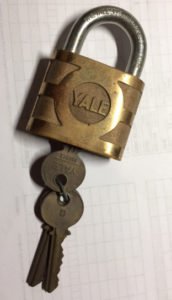 LA is wondering about her friend’s mind. The friend collects vintage locks and LA wants to know if this is an unhealthy obsession. No, LA, many folks collect vintage locks.
LA is wondering about her friend’s mind. The friend collects vintage locks and LA wants to know if this is an unhealthy obsession. No, LA, many folks collect vintage locks.
What exactly do these folks collect? Well, to list a few arenas, they collect:
- antique door plates, with highly decorated keyhole escutcheons, in Victorian styles as varied as the Gothic, the Spanish Colonial, the Greek, the Japanese
- vintage prison locks
- trick locks, called warded locks
- salesmen’s sample locks, cut away to reveal the working on the insides
- US postal service locks (I worry about those collectors)
- military locks
- railroad insignia locks
Finally, the greatest of all locks, the story lock. What are those? The front has one scene, which perhaps is a man’s mouth, and the back has another scene (I leave that scene to your imagination). LA, as many collectors exist as are types of locks. And this is because locks are symbolic of safety and security, symbolic of love and commitment.
LA’s friend has an older early 20th century Yale and Towne Manufacturing Company lock. In 1848, Linus Yale and his son developed the cylinder lock (pin and tumbler style). This differed from previous locks in that the Yale key had teeth, not a long shaft or shank. The blade of the Yale key was cut with teeth that fit inside to a matched cylinder. The teeth operate the tumbler. Still, Yale locks became easy targets for robbers once such keys were in use a few years. Yale’s son developed the combination lock with its numbered tumbler. However, you can’t stop a determined thief. Even those massive bank safes with combination locks became easy targets.
What was Yale to do? An employee developed a timing mechanism so the combinations only work during business hours. This was no deterrent to good ole dynamite.
Since Egyptian times, thieves have tried to outsmart a lock. The Egyptian lock was a wood beam on the inside of a door with a mechanical lever, turned with a large key, which lifted the beam. The Romans went one further and forged bronze or iron beams and accompanying keys to turn that lever. And just for added symbolic protection, the escutcheons were forged with warning animals or gods. These are highly collected.
Leave it to the prudent Swedes in the Middle ages to put some finesse into the Roman, and also Chinese, invention of the padlock. What a symbolic tool! Now everything could be locked. The Swedes created the useful arched and swinging shackle, large enough to join multiple hasps. The Middle ages, a superstitious era, decorated their iron padlocks with griffin and spirit faces. Always iron because in a throwback to pagan times, Hephaestus was the Greek forger of iron. By the late 18th century Swedes invented a padlock to ‘catch a thief.’ One in which a key could NOT be removed unless the key sprung all the right interior workings.
The French, typically, made locks beautiful from the 16th to the 18th century. The locked heart shaped padlock became a symbol for many Palace intrigues. Most Courtly fine French furniture of this era contained some kind of a lock. Some of the finest ‘Mobilers’ employed a decorative locksmith to finish a chest of drawers or an interior door.
The English dominated the locksmithing world in the late 18th to 19th century. Here we find the famous Chubb double tumbler lock, and Barron’s lever-tumbler. If you see an inscription on a lock stating ‘four way,’ that harkens back to the number of levers in the lock’s interior. The more levers the less pickable the lock. American and English locksmiths decorated their locks with fanciful company logos that inspired security, such as an engraving of a bulldog.
Whole divisions of collectible locks are those souvenir locks, engraved with company names, such as a railroad line, a bank, an insurance company, or auto firm. These fall into the advertising collectible.
One last word about door locks
The symbol of a secure home, a locked front door, is a modern invention. A door that is fitted with a built in lock, inside the door itself, was an invention of 1830, the mortise lock. These, when taken out of a doorframe, are collectible when they are decorated with a fun swinging keyhole cover.
LA, your pal is in good company. Her Yale lock is worth $75, largely because (and this is rare) it has its original key.
I have this same lock and original key. I am trying to pin point a date for this. Any ideas ?